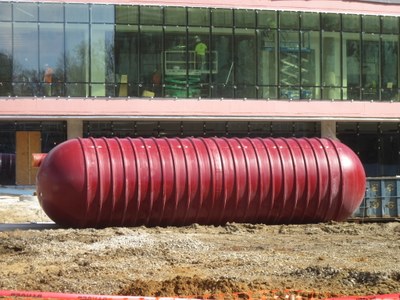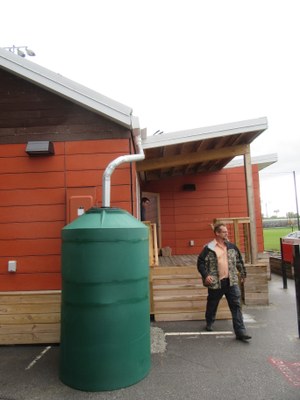Stormwater
Map of Belknap Stormwater Projects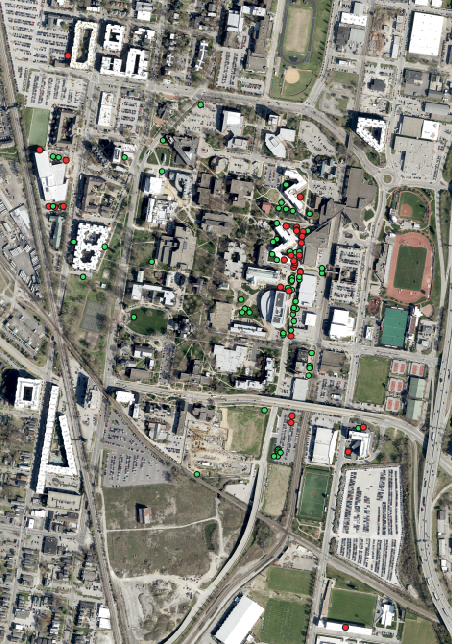
Flood watch: completed construction could curb calamities in campus cloaca
The massive, unprecedented flood which hit UofL on August 4, 2009, causing $21 million in damage to 92 campus buildings, was a wake-up call for many. The 7.2 inches of rain which fell in just 78 minutes hinted at the increasing intensity of storms to come as our greenhouse gas emissions continue to warm the planet and alter the climate we once knew. But it also helped motivate us to take action to both mitigate our climate impact, and to adapt to a changing climate by getting serious about sustainable stormwater management. Further flooding on May 29, 2012 not only validated our concerns, but demonstrated that our work since 2009 to enhance stormwater infiltration had already begun to pay off. Since then, UofL has installed dozens of underground infiltration systems and permeable surfaces all across Belknap Campus and incidents of flooding have become extremely rare.
UofL has worked closely over the years with Louisville's Metropolitan Sewer District (MSD) on a variety of "green infrastructure" projects to help keep stormwater runoff out of the combined sewer system. In the past, every raindrop that hit UofL's rooftops (over 2.2 million square feet on Belknap campus alone!) and pavements was channeled into the same sewer system that handles our sewage which truly needs to be treated. But, as our former Vice-President for Business Affairs, Larry Owsley put it, "When you have that much rain in that short a time, the sewers — which are large sewers — just back up and there's no place for the water to go." Even if the sewers can handle stormwater from UofL, the treatment plants at the end of the pipe often cannot, leading to dangerous releases of untreated sewage into the Ohio River - a threat to human health and ecological integrity.
UofL has pursued means of lessening the risk of flood and reducing our campus' contribution to the problem by diverting stormwater from the sewer system all together through infiltration and rainwater harvesting projects, or by slowing its release through water absorbing changes to our campus landscape. Around campus, we have disconnected downspouts, installed vegetated green roofs, and built rain gardens and bioswales to facilitate groundwater recharge through infiltration.
Want to disconnect your downspouts, too? MSD is offering residential customers $100 per downspout!
Stormwater Management Projects
In recent years, UofL made several changes to campus landscaping, parking lots and rooftops, with the help of $1.25 million in cost-sharing from MSD. In 2015, MSD confirmed that UofL's projects are diverting about 72 million gallons of stormwater every year! We think that this significant investment will essentially pay for itself by helping prevent millions of dollars in future flood damage. We are also hoping the projects at UofL will serve as an example for similar projects across the city on both public and private property. MSD's investment in Belknap campus stormwater projects is part of an $850 million agreement that MSD made in federal court with the U.S. Environmental Protection Agency and state regulators in 2005 to reduce the incidence of combined sewer overflows into waterways during storm events.
Projects at UofL include:
- Rain Barrels & Cisterns: UofL installed its largest cistern in 2018 at the Belknap Academic Building. The underground tank holds 50,000 gallons of storm water captured from the roof for irrigation. In 2016, UofL's Conn Center for Renewable Energy Research reinstalled the student-designed Phoenix House on campus with large rain barrels for landscape irrigation. The LEED Gold Student Recreation Center features a 30,000 gallon cistern to capture runoff from the roof (as well as HVAC condensate) for reuse in irrigation. Any excess is returned to the aquifer through a massive infiltration basin (see below). The LEED Gold Clinical & Translational Research Building at HSC also features a cistern to capture HVAC condensate for reuse in irrigation rather than draining to the sewer system. Rainwater harvesting from the roof of the Cultural Center for irrigation of the Garden Commons began in 2011, with a total storage capacity of 600 gallons. Three rain barrels with a total storage capacity of 350 gallons were installed in 2013 to capture water from the roof of the Urban Studies Institute (426 W. Bloom St.) for use in the Horticulture Zone garden behind the building.
- Bioswales: Vegetated bioswales are stormwater runoff conveyance systems which provide a natural alternative to sewers. They help reduce threats to water quality by infiltrating the first flush of storm water runoff and filtering the large storm flows they convey. UofL utilizes existing natural drainage swales whenever possible, and enhances them with native plants to encourage infiltration and filter out contaminants. A bioswale was designed to handle stormwater from the roof of the new College of Business expansion.
-
Rain Gardens: Areas of campus will be redesigned to channel runoff into shallow depressions which can be replanted with deep-rooted, native species to facilitate infiltration, converting a waste problem (runoff) into a beneficial good (groundwater).
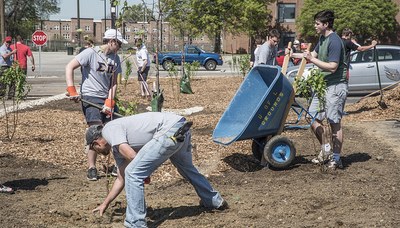 The first such project was installed in April 2016 in the Speed School parking lot, by the Sigma Pi fraternity, which worked with the Grounds crew to raise funds and volunteer labor as part of their annual ACE service project. The project involved removing 5126 square feet of grass at the southwest corner of the intramural fields in the Speed School parking lot. The grass was replaced with a mixture of native plants supplied by Dropseed Nursery and 4 Swamp White Oaks which will facilitate infiltration. Sigma Pi provided 27 volunteers (for a total of 175 volunteer hours) and raised funds for $1200 worth of plants. Had the university hired a third party to install the rain garden, it would have cost about $6000. Project benefits include:
The first such project was installed in April 2016 in the Speed School parking lot, by the Sigma Pi fraternity, which worked with the Grounds crew to raise funds and volunteer labor as part of their annual ACE service project. The project involved removing 5126 square feet of grass at the southwest corner of the intramural fields in the Speed School parking lot. The grass was replaced with a mixture of native plants supplied by Dropseed Nursery and 4 Swamp White Oaks which will facilitate infiltration. Sigma Pi provided 27 volunteers (for a total of 175 volunteer hours) and raised funds for $1200 worth of plants. Had the university hired a third party to install the rain garden, it would have cost about $6000. Project benefits include:
· Catching oils from parking lot before it reaches the drainage system;
· Providing pollinator habitat in an otherwise paved, desert area;
· Improved aesthetics; and
· Eliminated need for mowing.
Rain gardens have also been planned for the Law School courtyard and for the area between the Duthie Center for Engineering and the J.B. Speed building, but we lack funding to implement these projects at this time.
-
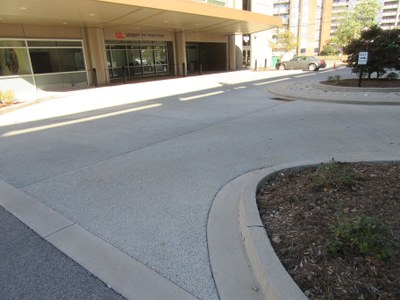 Pervious Pavements: UofL is moving away from the traditional method of creating hardscapes which prevent infiltration and channel stormwater to sewers. Instead, we are creating lots, roadways, plazas, and sidewalks by either: 1. Pouring pervious pavement, as was installed in the drop-off circle at the main entrance of the Dental School renovation in 2012 (with $17k in cost-sharing stipend from MSD); or 2. Laying permeable pavers, as have been used in the Red Barn plaza, University Tower Apartments plaza, and Grawemeyer Oval loop renovations, and the Garden Commons community gathering space.
Pervious Pavements: UofL is moving away from the traditional method of creating hardscapes which prevent infiltration and channel stormwater to sewers. Instead, we are creating lots, roadways, plazas, and sidewalks by either: 1. Pouring pervious pavement, as was installed in the drop-off circle at the main entrance of the Dental School renovation in 2012 (with $17k in cost-sharing stipend from MSD); or 2. Laying permeable pavers, as have been used in the Red Barn plaza, University Tower Apartments plaza, and Grawemeyer Oval loop renovations, and the Garden Commons community gathering space.
-
Green Roofs: Vegetated roofs are not only beautiful, but they help moderate temperatures to reduce the urban heat island effect and building energy demands for cooling and heating, while reducing storm water runoff, generating oxygen, and providing wildlife habitat in the urban landscape. They can also be designed as green spaces for urban dwellers looking to escape the concrete jungle. UofL has begun installing green roofs to help demonstrate their many benefits, with projects including:
1. In July, 2012, UofL officials gathered for a ceremonial planting of the new green roof sprouting on the first building at the new Nucleus Innovation Park-Market Street, a subsidiary of the UofL Foundation. The eight-story, 197,000-square-foot, LEED Silver building opened in May 2013 with a 6,000 sf fully reflective roof. Bernheim Forest nursery specialists were involved in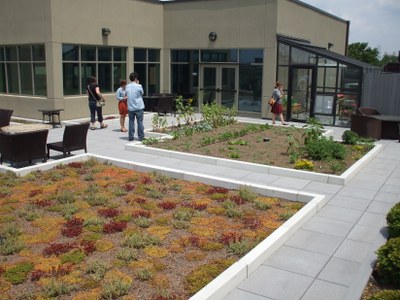 advising building contractors how to design and maintain the roof, which features Kentucky native plants;
advising building contractors how to design and maintain the roof, which features Kentucky native plants;
2. The new M. Krista Loyd Sky Garden atop the College of Business Equine Addition, is a 942-square-foot area of pre-vegetated sedum mat with 4”-6” fill material installed in 2012;
3. An accessible roof patio planted with sedums and a vegetable garden atop the Early Learning Center at Family Scholar House, at the northwest corner of Belknap Campus; and
4. a huge vegetated roof installed atop the Cardinal Towne affiliated student housing and retail facility which opened on Cardinal Blvd. in 2011.

- Infiltration Basins: Many traditional-looking parking lots, plazas and lawns across campus now conceal advanced stormwater infiltration systems. Instead of draining to the combined sewer system, these areas drain to large underground infiltration basins capable of handling huge rainfall events and the water from surrounding rooftops. These designs were included in the following projects (with the square footage of impervious surface area mitigated and project cost in parentheses):
- Belknap Academic Building (east) - In April 2019, UofL depaved Brook Street through campus from the Lutz Circle at University Blvd. north to the SAC. This site, where we had long suffered some of the worst flooding after paving over an historic brook, was transformed into a more permeable bike and pedestrian plaza with a massive underground stormwater infiltration system and new trees to help prevent flooding. This project was part of the site redevelopment of the LEED Gold Belknap Academic Building. See photos here.
-
Belknap Academic Building (west) - This LEED Gold facility was designed to include an infiltration system in the plaza to the west which captures roof run-off from the new building, as well from Shumaker Research Building, Schneider Hall, and Lutz Hall. The system was installed in March 2018. See photos here.
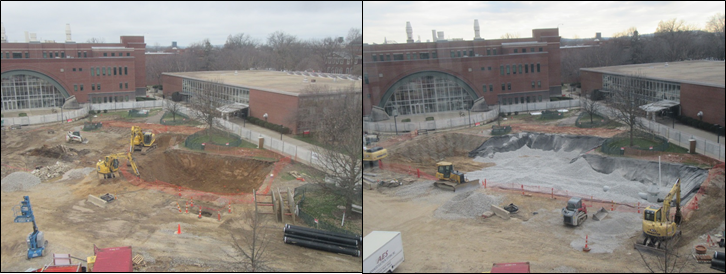
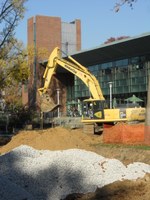
- Lynn Soccer Stadium - This LEED Silver facility was built in 2014 with an infiltration system beneath the playing field to capture roof run-off from stadium buildings (17,030 sf)
- The new College of Business Equine Addition built in 2012 ($6k)
- Ekstrom Library western lawn - completed in fall 2012, this infiltration system captures roof run-off from surrounding buildings - Ekstrom, Jouett & Law School north roof (108,000 sf, $260k)
- The UTA/Ville Grill plaza renovated in 2011. (14,550 sf, $29k)
- The parking lot behind Bettie Johnson Hall, the Urban Studies Institute, and University Planning, Design & Construction renovated in 2011. (67,629 sf, $135k)
- The Red Barn plaza renovated in 2011. (4,120 sf, $8k)
- The College of Business parking lot renovated in 2011. (86,052 sf, $306k)
-
 The Grawemeyer Oval lawn renovated in 2011. (76,368 sf, $153k)
The Grawemeyer Oval lawn renovated in 2011. (76,368 sf, $153k) - The Speed Museum expansion project has been designed with a large infiltration basin beneath the plaza which will be able to handle roof drainage from Strickler Hall, Life Sciences, and the College of Business. (94,304 sf, $217k)
- The new Student Recreation Center opened in October 2013 with an infiltration system that is larger than originally planned. It has a connected load that captures rainwater from most of the land surrounding Billy Minardi Hall as well. This innovative system has decreased the stormwater discharge by approximately 90% from the pre-construction parking lot condition of the site.
 Until design capacity has been met the system captures all 7.2 acres of storm water runoff without discharge into the public storm sewer system. The entire volume of stormwater discharge from all impervious surfaces, including building roof areas, parking areas, plazas, synthetic turf fields and walkways, is detained in subsurface infiltration basins that are located below the parking and plaza areas. The system design capacity is so efficient that it will accommodate the rainfall of a near 500 year, 6 ½”/ 24 hour rain event. This exceeds the local requirements of the Metropolitan Sewer District. A rainwater harvesting system works in concert with the stormwater management system by
Until design capacity has been met the system captures all 7.2 acres of storm water runoff without discharge into the public storm sewer system. The entire volume of stormwater discharge from all impervious surfaces, including building roof areas, parking areas, plazas, synthetic turf fields and walkways, is detained in subsurface infiltration basins that are located below the parking and plaza areas. The system design capacity is so efficient that it will accommodate the rainfall of a near 500 year, 6 ½”/ 24 hour rain event. This exceeds the local requirements of the Metropolitan Sewer District. A rainwater harvesting system works in concert with the stormwater management system by  capturing stormwater from impervious surfaces, primarily building roof surfaces, and using the captured water for site irrigation. In addition, condensate water, a byproduct of the building’s HVAC system, is completely discharged into the rainwater-harvesting tank and further contributes to the site irrigation needs, mitigating discharge into the sewer system. During times when the rainwater harvesting system is not in use, overflow systems are utilized to discharge the unused runoff into the infiltration basins where the rainwater can be absorbed into the permeable soil and aquifer without discharging into Louisville's combined storm sewer system. (317,115 sf, $390k)
capturing stormwater from impervious surfaces, primarily building roof surfaces, and using the captured water for site irrigation. In addition, condensate water, a byproduct of the building’s HVAC system, is completely discharged into the rainwater-harvesting tank and further contributes to the site irrigation needs, mitigating discharge into the sewer system. During times when the rainwater harvesting system is not in use, overflow systems are utilized to discharge the unused runoff into the infiltration basins where the rainwater can be absorbed into the permeable soil and aquifer without discharging into Louisville's combined storm sewer system. (317,115 sf, $390k) - The Nucleus, a 197,000sf LEED-Silver innovation center operated by the UofL Foundation at Market & Floyd Streets, features a 6,000-square-foot vegetated roof and a system that captures 90 percent of stormwater via a retention basin under the building. This project was made possible via a partnership with the Metropolitan Sewer District.
Researchers from UofL's Center for Infrastructure Research have installed monitoring equipment to study infiltration rates, storage capacity, and the performance of these designs.
Universities Council of Water Resources
In 2014, UofL joined the Universities Council of Water Resources, an association of institutions and individuals representing various fields of natural and social sciences who are at the forefront of education, research, and public service around water resources. Membership provides reduced registration fees to UCOWR conferences for all UofL employees and students, as well as electronic subscriptions to the Journal of Contemporary Water Research and Education, participation in UCOWR governance, networking with other water scholars, and increased visibility as among the leading universities in water-related research across disciplines. Law Professor Tony Arnold (502-852-6388) serves as UofL's lead delegate to UCOWR.

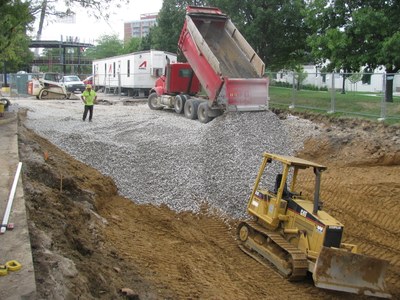 MSD hopes to save money, property by 'greening' University of Louisville
MSD hopes to save money, property by 'greening' University of Louisville